Patrt VI: Hot Water in Aguas Calientes
*This post originally appeared on the blog in early 2018…We have re-posted for the enjoyment of all during our ‘Summer re-runs” while Brian and Sylvia are in search of new adventures.
The third day of the trip began with the hostel’s resident walking alarm clock, a huge Rex Goliath rooster, announcing the coming of the sun starting a good three hours before it was actually up. Breakfast, and then on the road for what would be the last full day of hiking for us.
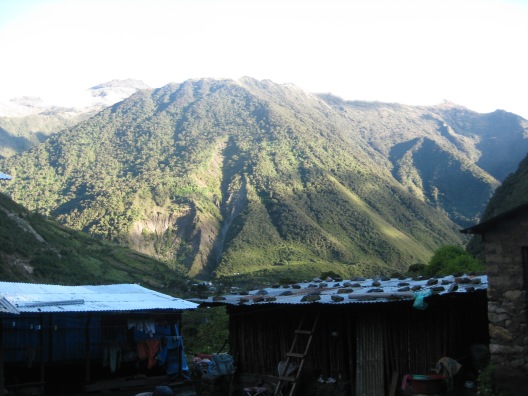
Today’s day of hiking would be the easiest of the three. The guide, Willie, gave us the option of hiking down along the left side of the valley (more scenic, but harder) or the right (easier, but a lees scenic road walk.) The group gamely chose the left, though not without a few grumbling dissenters.
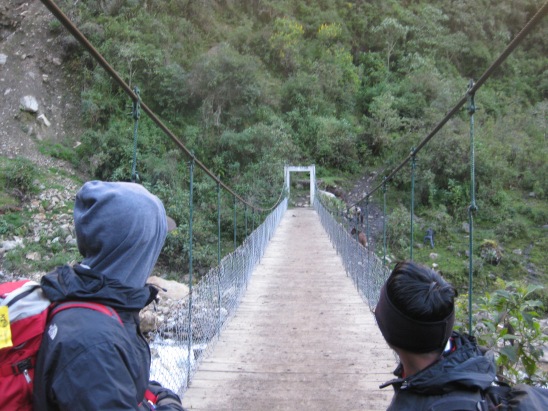
We were told that it was all downhill. This turned out to be mostly true…it was all downhill, except for those sections that were uphill. There were few of these to be fair, and mostly it was a level walk over a reasonably good, but often muddy, trail.

There were however several washed out sections and some of these were frighteningly bad. In 2013, a series of mudslides stranded nearly 700 tourists on the Inca Trail itself and perhaps as many as 2000 more in the area of Machu Picchu…And in 2010, at least two people were killed on the trail by mudslides. Though rare in the US (except maybe in coastal California) mudslides are a fact of life in virtually all tropical areas with any kind of vertical relief the world over, and are estimated to kill thousands every year. It’s no joke; if you do this trail, don’t go in the rainy season (in fact you cannot even hike the classic Inca Trail in the worst month, February.)
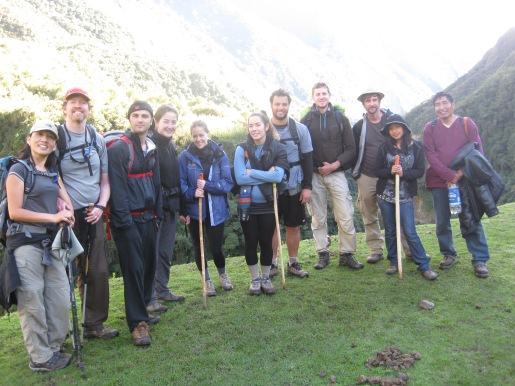
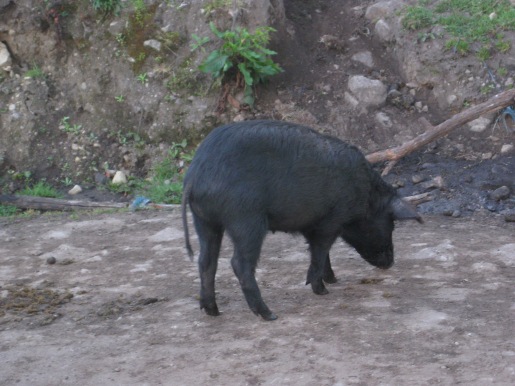
Here’s a story of a severe washout from the 2017 season…
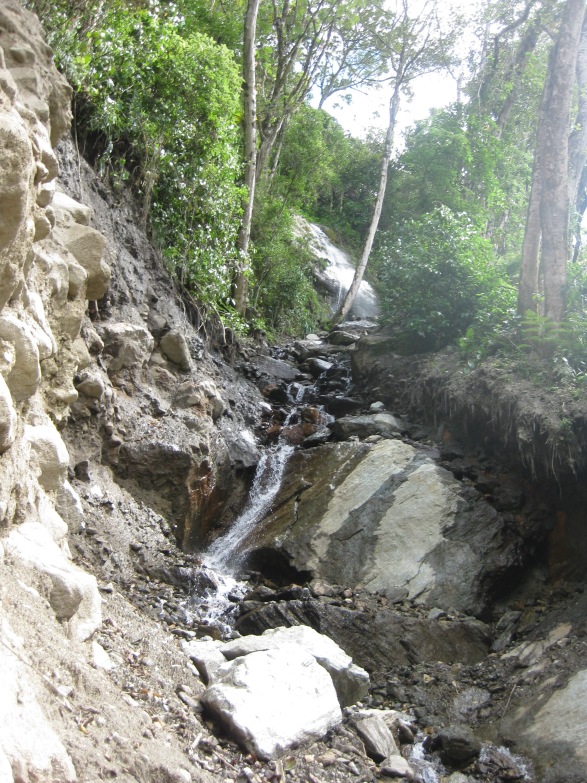
The trail wound down through the jungle getting closer to the level of the river below…which turned out to be a tributary of the Urubamba. On the way we passed plantations where coffee, coca, bananas, and avocados were grown (all of the crops endemic to high jungle hillsides, in other words.) Willie told us that Spectacled bears (Andean Black Bears) had once been common along the trek, but increased human activity had driven them higher into the hills. I was also disappointed to find there were no monkeys at this elevation. I had still yet to see my first monkey in the wild…though my wife might argue I see one every time I look in the mirror.
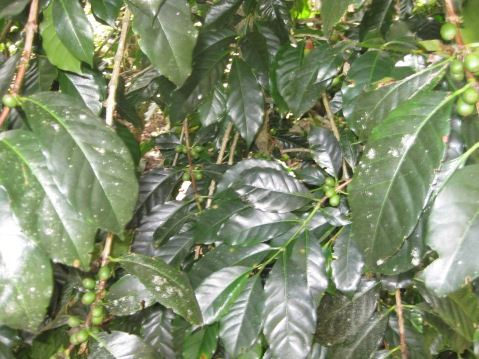
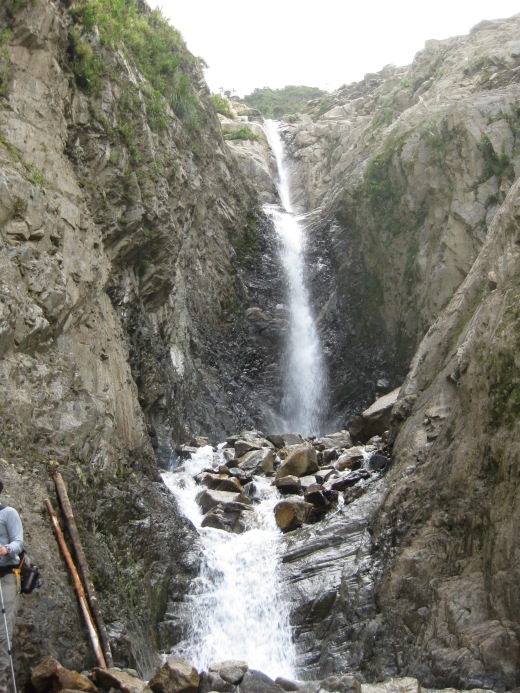

We eventually arrived in out days stopping point, the village of Santa Teresa. Most of the travel guides for the Salkantay trek advise people to bypass Santa Teresa, which is not particularly scenic, and hike directly to the rail station at Hidroelectrica instead (which, while harder, gives you a view of Machu Picchu) if time permits. In our case time did not permit; we had only four days to work with.
And so, after lunch, sadly, we parted with the main group which continued on to Machu Picchu on foot. We joined a sub group of the party that included ourselves, the Peruvian Doctor and his daughter, and a young French Canadian man named Marco that went, by circuitous route, to the train station.
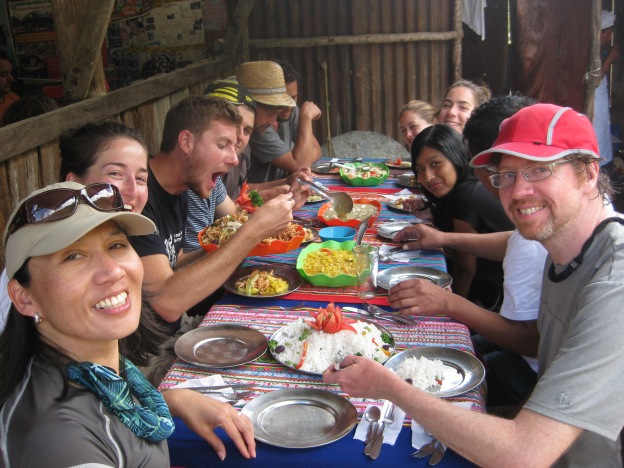
This car ride was in itself an epic that could probably fill five pages. In the remote areas of Peru, having a car (or train) does not necessarily make travel faster or easier. The car in question left the village, stopping at least twice to pick up or let out passersby on the road who the driver apparently knew; and once while a fallen banana tree that blocked the road was cleared. Having attained the bottom of at the bottom of the valley, the car snaked along a recently cleared road past the remains of several washed-out bridges, then negotiated one still awaiting washout, and struggled up the opoosite bank.
At length it arrived at a short, fully paved section of road which, as fate would have it, was under construction by a massive road crew men and heavy equipment. The car simply zipped past the road closed signs and went on through, which resulted in a brief argument between the driver and a female construction foreperson in a hardhat. On down the river along slightly better roads maintained by the Peruvian government to support the impressive hyrdroelectrical facilities that bring power to this entire area. At one point, we passed a huge and obviously man-made bore hole in a sheer cliff side, out of which poured thousands of gallons of water. Part of the public works, we were told.
At the train station of Hidroelectrica it was time to get out, stand around and wait. The train was there, but obviously not going anywhere soon. From the station to Machu Picchu is about a three-hour hike through the jungle along the railroad wayside, and many of the ubiquitous young European hikers were doing just that. But exhausted after a car ride like the one we had just endured, we thought the option of sitting down and waiting for the train to get under way to be just fine, thank you.
Hundreds of people milled about on the train platform. Many of these were tourists. The tourists have their own air-conditioned waiting room, and get to ride on the best and roomiest rail cars where there are actual seats to be had. The locals have it less well. A queue of at least a hundred stood waiting in line at the ticket counter; the line was not moving. As the average local man stands closer to five feet tall than six, I was able to look over the entire line. Men, women, children, some carrying bags or dogs or smaller children or chickens. None of the locals seemed in the least perplexed. Waiting for things to happen is, for them, simply a part of life. The train was not ready; the train would be ready, soon, and until it was there were far worse things one could be doing then standing around, waiting.
We checked in at the ticket window…our line moved with lightning speed compared to the local line, but still, it took a good twenty minutes to complete the transaction. We clearly saw a computer and mouse on to the ticket agents desk, and yet they still hand wrote every-thing in an old style triplicate form ticket book, one of the copies being handed to us. “That wasn’t bad,” Willie told us. “You should see it when the computers are down.”
After an hour of waiting in the air-conditioned gringo-euro tourist room, things began to happen. First, cargo started to be loaded into the train. A huge cacophony erupted as a rail porter began dragging a six-foot-tall canister of what appeared to be acetylene for welding torches, using the rail as a kind of conveyor belt. Tourists who had been lazily lounging on the rail, using it as a seat, scattered in all directions; the porter betrayed no reaction and just moved briskly past. Finally, a man dressed as an engineer appeared, walked to the train and stared the engine. People began to make their way out and we followed the crowd.
The PeruRail narrow gauge railway to Aguas Calientes is, barring walking, the only way to reach this remove mountain enclave which forms the gate to Machu Picchu. It makes an interesting trip in itself, though if I ever do it again I think I would want to walk, which looks pretty cool. But it is a comfortable and easy ride, to which I simply have no complaint.
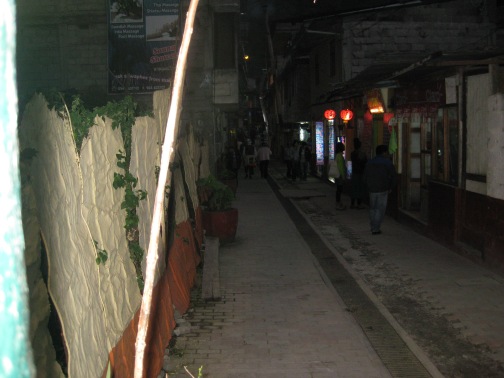
Reaching Aguas Calientes, it was off the train and into complete, no holds barred confusion. People milled about yelling; porters were wheelbarrows and rickshaws were running about, and scores of tourists were searching frantically through piles of bags for their own luggage. We managed to locate ours, then went in search of our hotel. No easy task, this…there are no taxies in Aguas Calientes. There are in fact no cars, except for a few emergency vehicles, and almost no streets where a car could fit. If you want to go somewhere you must walk, and if you have something to carry and don’t want to carry it, you have to hire someone to do it for you (and there are no shortage of those who will.)
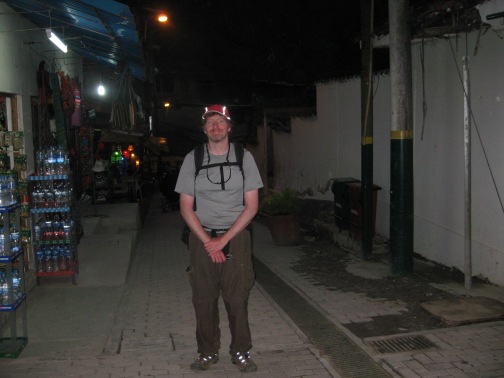
We set off, pulling our suitcases behind us; first up the train ‘platform’, a gravel space filled with every conceivable thing a bustling tourist community might need. Pallets full of boxes of fruit and frozen chicken stood beside others stacked with concrete and re-bar, while beside these were huge, modern commercial grade air conditioning units sitting in shrink wrap, all waiting for somebody or something to come and claim them.
After clearing this maze of cargo, we entered the cobblestone streets of Aguas Calientes…which means, in Spanish, ‘Hot Springs’. And we found ourselves immediately in hot water. The streets are basically narrow alleyways, congested with human traffic and booths with any number of things for sale. Small children darted about; Sylvia warned me of pickpockets and refused to let me, the Gringo, AKA Target Seguro, out of her sight.
Try as we might, we couldn’t figure out the maze of streets, and it was growing darker. At length we found a police officer in a plaza, who directed us to a nearby man in a suit with a walkie-talkie who turned out to be none other than the chief of police for the whole town. This man, who was exceptionally kind and spoke English almost perfectly, not only gave us directions to the hotel but smiled and said, “Come, I’ll show you where it is!” He marched us through the streets of the little town and in no time at all we found our hotel…which turned out to be one of the last buildings in the town before the road turns back to the Inca Trail and vanishes out into the jungle.
If Machu Picchu (which cannot be seen from the town) were not here, Aguas Calientes certainly would not be what it is today. It might not be at all. But regardless, this tiny town with a train going right through the center of it is perhaps the most fascinating human inhabited city I have ever visited. Touristy it may be, but the setting is inarguable. In addition to being strangely beautiful, it is the closest thing to walking right onto the set of an Indiana Jones movie I have experienced thus far in my life.
We dined and slept that night in comfort…in the morning, we would rise and meet our guide Willie in the lobby of the hotel, to venture out to the place we’d been walking toward all along…the most celebrated historical site in the New World…Machu Picchu. It was just a few miles away now.

Next: Part VII…The Lost City of the Incas